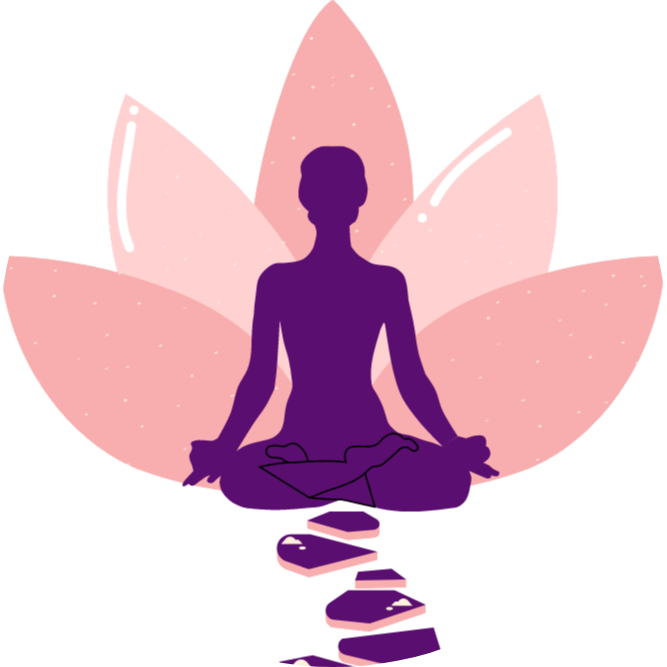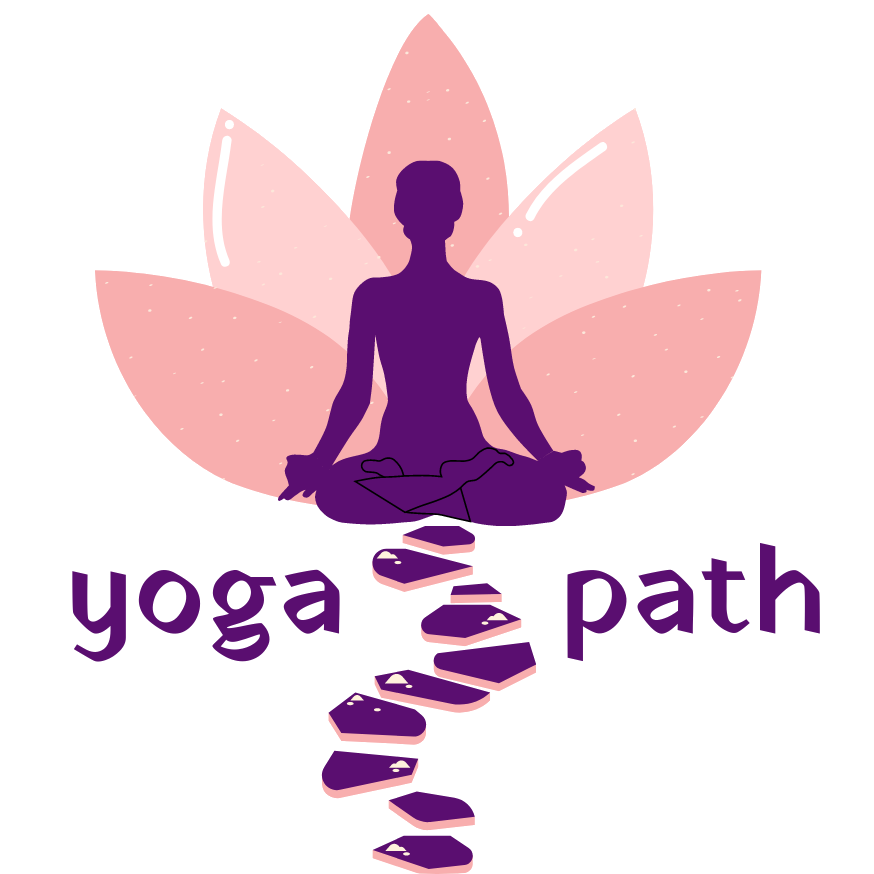Learn Asanas - Standing Poses
Standing Asanas are foundational poses that are performed while standing, strengthening your leg muscles, calves, glutes, expanding your chest, stretching your entire body, burning stored fat, and toning your body.
These Asanas help you connect with the earth and develop a sense of stability in your life through ‘grounding.’ They also boost immunity, improve circulation, increase agility, reduce stress, and anxiety.
Some simple Standing Poses include Talasana, Trikonasana, Samakonasana, Dwikonasana and Ekpadasana.
Talasana
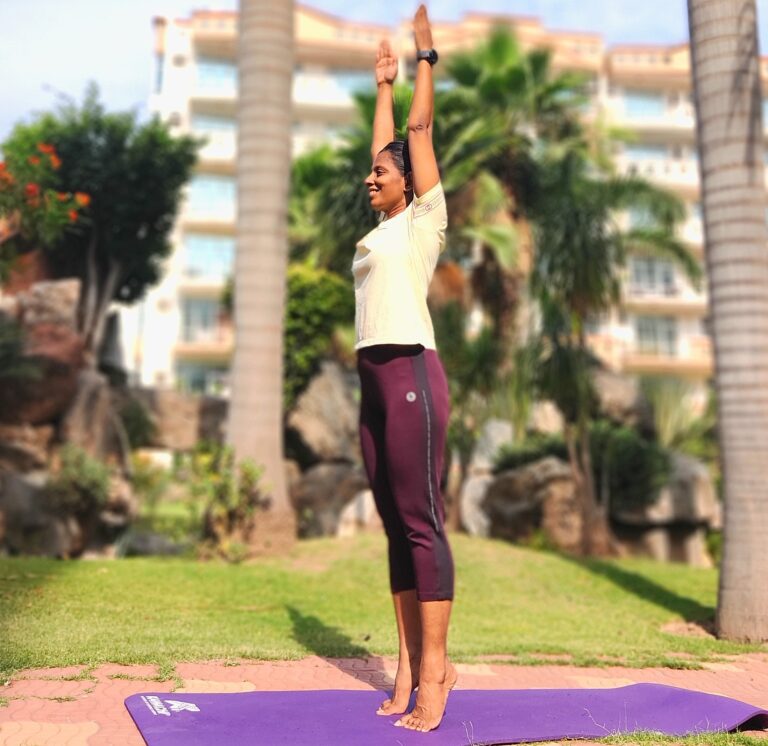
Standing Position – Upward Stretch
In this pose, stand erect with hands at their respective sides. Keep the feet parallel to each other and maintain a one-foot distance between them.
1. Inhaling, raise both arms up above head. Keep the arms close to the ear.
2. Simultaneously, raise both the heels, to achieve a maximum stretch of the body.
Synchronise the first two steps, while inhaling, in 3 seconds.
Now, balancing on the balls of the feet, with the completed upward stretch of the arm and the body, keep the gaze straight ahead and maintain the pose for 6 seconds, retaining the breath (final position).
Return to starting position:
Turn the palms to face outward and then exhaling, bring the arms down keeping them straight through a backward and downward circuit. Simultaneously, lower the heels to assume the starting position.
Contraindications:
Frozen shoulders, Arthritis, Hypertension and serious cardiac complaintsBenefits:
Helps increase the girth and contour of the chest.
Develops the respiratory muscles and the vital index.
Improves elasticity, capacity and circulation of the lungs.
Improves the venous flow –equalises blood circulation.
The flexibility of the spinal column improves.
Tenses/tones the usually relaxed muscles of the abdomen.
Muscles of the leg are toned and improvement in the functioning of the veins.
Due to the stretch of the vertebral column, undue pressure on the vertebrae is relieved.
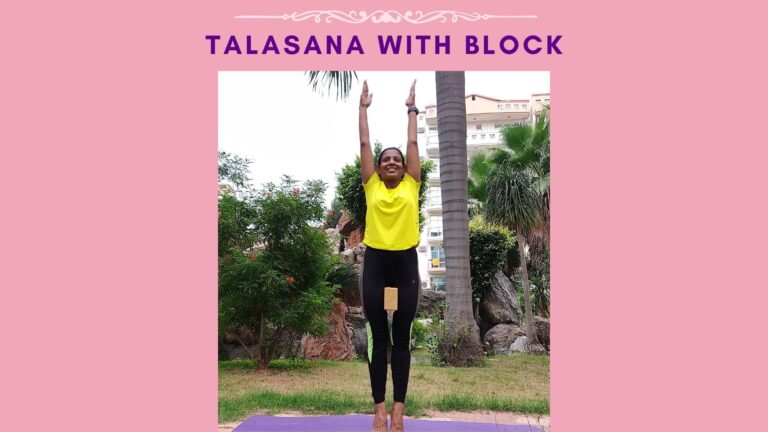
Standing Position – Upwards Stretch
Talasana or Palm Tree Pose – variation with a block.
In this pose, stand erect with hands at their respective sides. Keep the feet parallel to each other and maintain a one-foot distance between them. Place a block between your thighs.
Inhaling, raise both arms up above the head. Keep the arms close to the ears.
Simultaneously, raise both the heels, to achieve a maximum stretch of the body. Synchronise the first two steps, while inhaling, in 3 seconds.
Now, balancing on the balls of the feet, with the completed upward stretch of the arm and the body, keep the gaze straight ahead. You can increase the pressure on the block to get more engagement of the adductor muscles in the legs, and maintain the pose for 6 seconds, retaining the breath (final position).
To return to starting position: Turn the palm to face outward and then exhaling, bring the arms down keeping them straight, through a backward and downward circuit. Simultaneously, lower the heels to assume the starting position.
Contraindications:
Frozen shoulder, Arthritis, Hypertension and serious cardiac complaints.
Benefits:
Maximum stretching of the body helps in increasing height
Co-ordination of muscular activity
Helps increase the girth and contour of the chest
Develops the respiratory muscles and the vital index
Improves elasticity, capacity and circulation of the lungs
Improves the venous flow and equalises blood circulation
Improves flexibility of the spinal column
Tenses/tones the usually relaxed muscles of the abdomen
Muscles of the leg are toned and improvement in the functioning of the veins
Due to the stretch of the vertebral column, undue pressure on the vertebrae is relieved.
Pressing of the block:
– Strengthens the adductors and abductor muscles (inner thigh and outer thigh muscles), which in turn strengthens the knees.
– Helps engage the pelvic floor.
– Strengthens the core muscles.
Uthkatasana
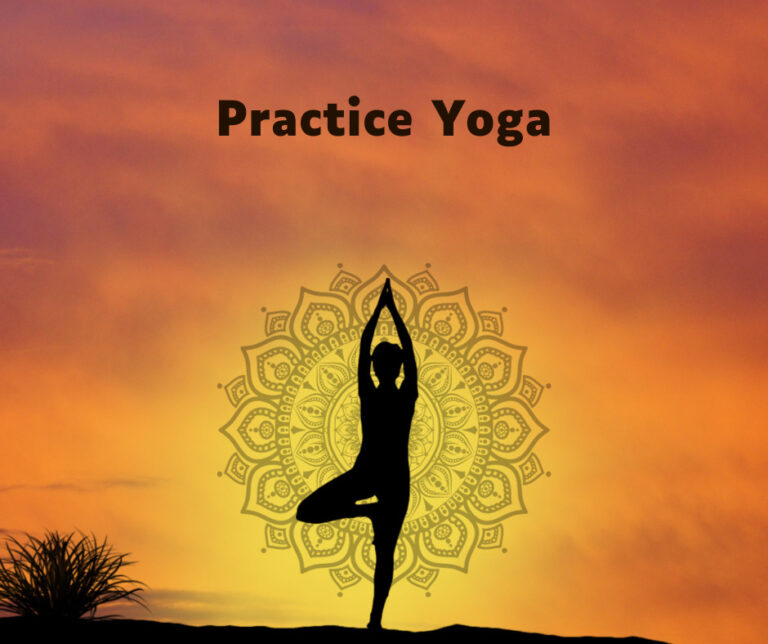
Standing Asana
Uth – means raise, kat means waist. This pose is also known as the Chair Pose.
Stand with your feet slightly apart. Stretch your hands to the front with palms facing downwards, with elbows straight.
Bend the knees and gently push your pelvis down and backwards as you exhale in 3 seconds as if you are sitting on an imaginary chair.
With awareness, sit straight and lengthen your spine.
Relax. Sink deeper into the chair.
Hold for 6 seconds – gradually increase to 1 minute.
Ensure that your knees don’t bend and cross ahead of your toes.
Inhale straighten up and lower arms to your side. Breathe and smile when holding this pose.
Contraindications:
Chronic knee pain, Arthritis, Ankle injury, any Knee problem or damaged ligaments and pain in the lower back. Headache or Insomnia (sleeplessness).
Benefits:
Exercises the spine, hips, shoulders and chest muscles.
Helps strengthen the lower back and torso.
Tones the thigh and strengthens them as well as ankle, leg and knee muscles.
Stretches Achilles tendon and shins while healing flat feet.
Strengthens the muscles that support the knee.
Tones digestive organs and opens heart.
Balances the body and brings determination in the mind.
Hastapadasana
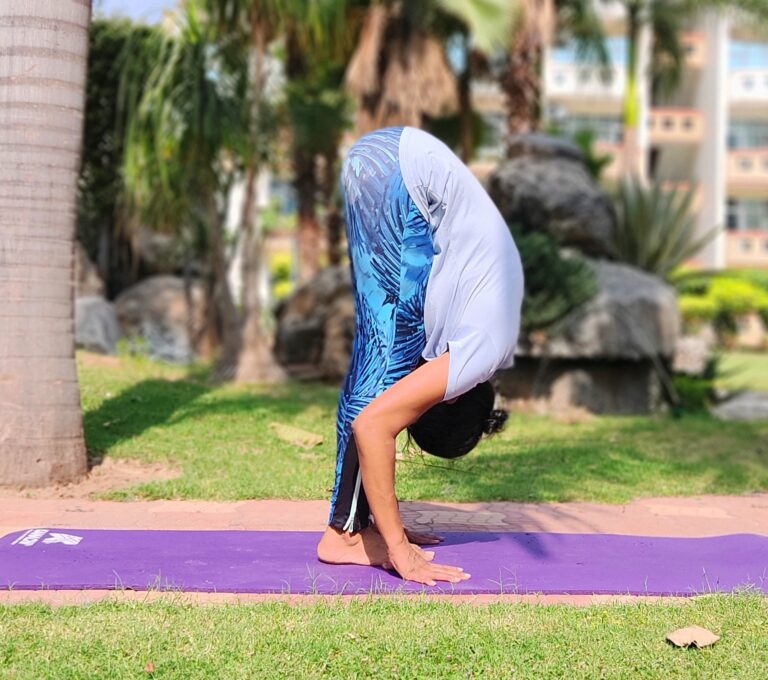
Standing Inverted Position – Forward Bend
Hastapadasana meaning Hand to Feet Pose
This asana flows with humility and acceptance of the self along with surrender to the universe. It represents a cycle of energy generated within the body and offered to the universe.
Stand with your feet together and hands at the side.
While inhaling, raise both your hands from the front above your head.
While exhaling, bring the your hands down to touch your toes or grasp your ankles keeping your knees straight.
Remember to keep your ears and hands together as a unit as you bend down or rise up. Keeping your knees straight, try to touch your forehead to the knees. Stay in the position for 6 seconds breathing normally – extend to 2 minutes.
While inhaling, raise your hands up above your head and exhaling bring your arms down to the sides.
Contraindications:
Hypertension, Cardiac ailments, Pregnancy, Peptic ulcers, Hernia, Back or Spinal Injuries, Cervical spondylitis, Slipped disc and serious Eye disorders such as glaucoma and myopia.
Benefits:
Results in extreme stretching of back and leg muscles
Brings flexibility to your spine
Abdominal compression provides good circulation and massage to abdomen and pelvic organs
Tones the abdominal wall and reduces unnecessary fat deposits in the abdominal area
Induces clavicular breathing and aids proper ventilation of the uppermost part of the lungs
Stimulates the nervous system and endocrine system
Improves blood circulation
Aids sleep
Virabhadrasana 1

Standing Asana
Virabhadrasanas is also known as the Warrior Pose.This pose is named after Veerabhadra, a fierce warrior and an incarnation of Lord Shiva. It refers to the “spiritual warrior”, who bravely does battle with the universal enemy – self-ignorance (avidya) – the ultimate source of all our suffering.
Stand straight with your legs wide apart by a distance of at least 3-4 feet.
Turn your right foot out by 90 degrees and left foot in by about 15 degrees. The heel of the right foot must be aligned to the centre of the left foot. Face the right side. Lift both arms and join your palms above your head. Make a salutation pose or Namaskar pose with your palms above the head.
Breathing out, bend your right knee. Ensure your right knee is in a straight line with right ankle and the knee does not overshoot the ankle. Gaze ahead.
Make a gentle effort to push your pelvis down.so that the right thigh is parallel to the floor and the left leg is straight at the knee and pushing into the outer part of the left foot. Hold the yoga posture with the determination of a warrior. Smile like a happy smiling warrior. Keep breathing .
Breathing in, raise up straightening the knee Breathing out, bring your hands down from the sides.
Repeat the yoga posture for the left side (turn your left foot out by 90 degrees and turn the right foot in by about 15 degrees).
Contraindications:
Vertigo – if you are suffering from vertigo, place your feet wide enough to get a good balance.
High blood pressure, heart problems – don’t stretch arms over the head.
Hip injury or if you recently had hip replacement surgery, you must refrain from practicing this asana.
Benefits:
Strengthens and tones the arms, legs and lower back.
Strengthens and tones hips, thighs, ankles, calves, abdomen, shoulders, arms and back.
This asana strengthens shoulders and relaxes them.
Strengthens the quadriceps, gluteus maximus, calf muscles, and hamstrings.
Strengthens knees.
It increases the stamina of the body.
It is likewise an effective asana for those who are in sedentary jobs.
Strengthens core and shoulders.
Engages the deep core muscles, which helps create stability and improve balance.
Can help alleviate pain cause by sciatica.
Helps improve circulation in abdomen and is useful for the digestive system.
Relaxes the mind and the body.
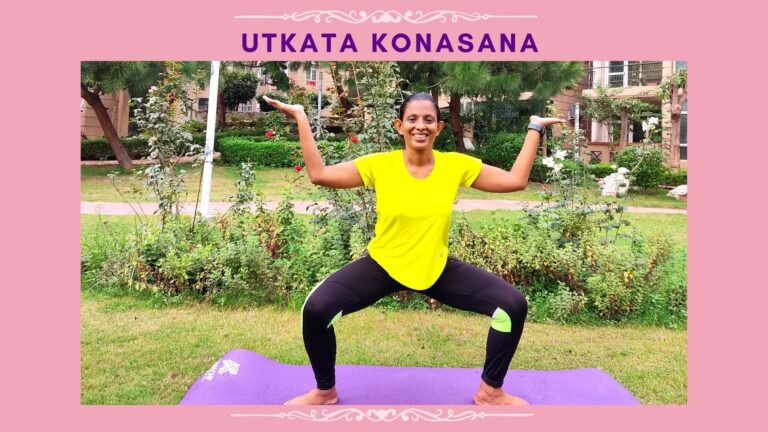
Standing Pose
Utkata Konasana is also known as Goddess Pose.
Stand erect with the hands freely by the sides.
Take the feet about 3 feet apart. Turn your feet outwards with the toes pointing away from the body and the heels pointing towards the body.
Now bend your knees till the thighs become parallel to the ground like a wide squat.
Bring both your palms together in the Namaskar mudra and place it in front of the chest. (Other variations include placing the hands parallel to the ground with the palms facing upwards.
Roll your shoulder out and backwards, expand the chest forward and gaze forward.
Breathe normally and deeply in this position. During exhalation, contract the abdomen and press the lower back down and feel the pressure on the thighs. Maintain this position for as long as you are comfortable.
To release the pose, straighten the knees and raise yourself up and bring the feet closer. Then lower your hands down.
Contraindications:
Utkata Konasana should be avoided by those suffering from hip, ankle and severe knee injuries. shoulder injuries.
Benefits:
Strengthens the hips, the lower back and the thigh muscles. This in turn strengthens the knees.
Expands the uterus before pregnancy and helps during pregnancy.
Helps to expand the chest and improves posture
Massages the organs in the abdomen, particularly the kidneys, the ovaries, urinary system and the prostate gland
Relieves menstrual pain and cramps
Expands the lungs and improves respiration
Energizes the body, relieves stress and gives a general sense of well-being
Samakonasana
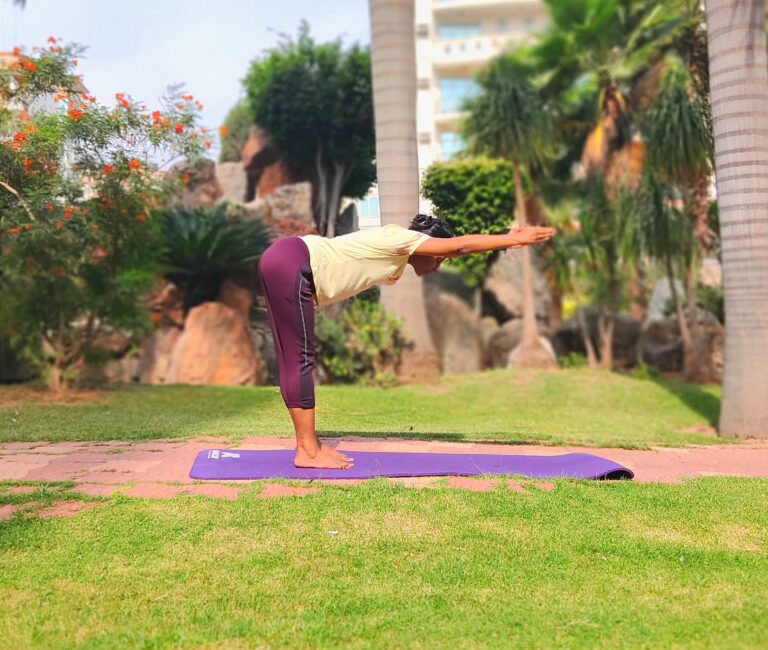
Standing Position – Forward Bend
Sama meaning straight , Kona meaning angle
In this asana we start with feet one foot apart the feet parallel to each other and arms relaxed by your sides As you inhale raise both hands straight above with elbows straight arms close to ears. As you exhale bend forward from waist with arms also straight ahead and close to ears. The back must be straight and parallel to the floor, lengthen the spine. As you inhale, raise the torso and arms back up and lower them down to sides.
Contraindications:
Back injury , Knee injury, Joint pain and Migraine
Benefits:
Strengthens and stretches back muscles
Strengthens quadriceps and hamstrings
It stretches abdomen and helps massage abdominal organs
Helps relieve constipation, indigestion and gas problems
Also helps increase metabolism
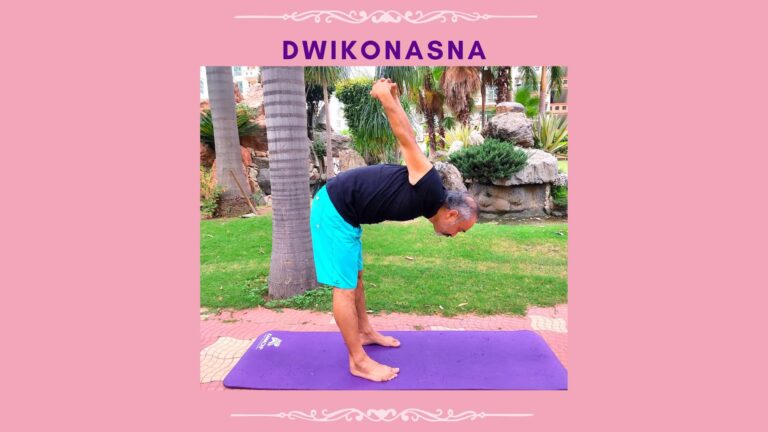
Standing Position – Forward Bend Asana
In this asana, stand erect with hands at your respective sides. Keep the feet parallel to each other and maintain a distance of 3 feet.
Inhaling clench the fists and raise the arms up, keeping the arms close to the ears. Interlacing the fingers of the up-stretched arms, above the head, arch back the spine, keeping the lower body, below the waist fixed.
Exhaling, unlocking the fingers, bend forward and downwards and bring the up-stretched arms to touch the ground. continue to bend the upper part of the body, till the forehead is parallel to the floor.
Freely swing the arms, first backward then raise it upward and backward until they come to a vertical position behind.
Hold this position for few seconds with fingers interlocked and the shoulder blades gently squeezing together.
Inhaling, bring the arms down to touch the ground. Then slowly while inhaling lift the body to return to the upright starting position, ensuring the arms and head are kept in position.
Benefits:
Strengthens both the muscles of the chest and waist.
Strengthens the muscles of the back, neck, spine and shoulders.
Improves flexibility and strength of shoulders.
Opens the shoulders improves mobility of shoulders.
Creates abdominal pressure and stimulates the intestines.
Stimulates sluggish liver and colon and provides relief in case of constipation.
Contraindications:
Spinal injuries, Cardiac conditions, High blood pressure, High myopia, Glaucoma, Hernia, Piles and Abdominal inflammation.
Urdhva Uttanasana
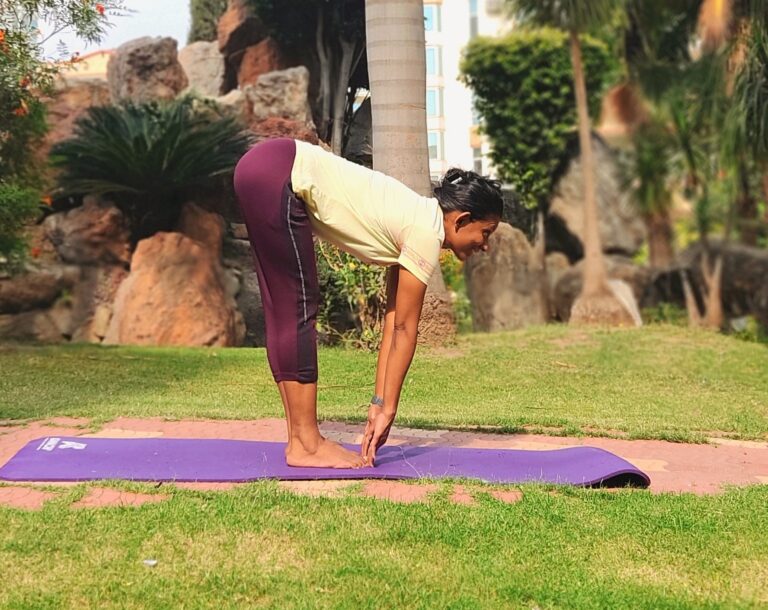
Standing Position – Forward Bend
Urdhva – upward or lifted – stretched Asana – pose
In this pose, keep your feet one foot apart, parallel to each other.
Lift arms up above as you inhale in 3 seconds, keeping arms close to your ears.
As you exhale in 3 seconds lower arms and bend torso too. Continue lowering arms till they touch toes. Lift chest. The arms are by the ears and head and hands move as one unit.
Lengthen the spine, and look up so the back is flattened and is parallel to the floor. Hold this pose for 6 seconds.
As you inhale in 3 seconds, raise the torso and arms back up and exhale in 3 seconds and lower them down to the sides.
Practise 3 rounds.
Contraindications:
Lower back injury, Glaucoma, Tear in the hamstrings, High blood pressure, Abdominal hernia, Cervical – don’t stretch neck up or down.
Benefits:
Strengthens and stretches back muscles
Strengthens quadriceps and hamstrings
It stretches abdomen and helps massage abdominal organs
Helps relieve constipation, indigestion and gas problems
Also helps increase metabolism
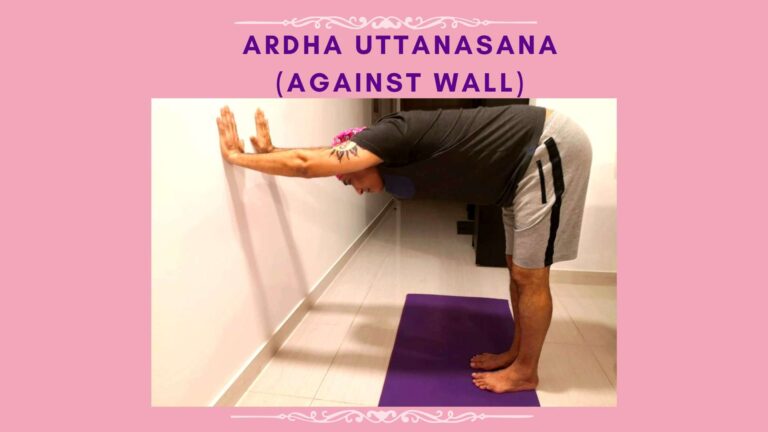
Standing Position – Forward Bend – Half stretched fold
In this pose, keep feet one foot apart parallel to each other. Place your hands on the wall ahead of you at hip height and walk back until your heels right below your hips and legs are straight.
Distribute your weight evenly on both feet, and press evenly into the soles of the feet. Straighten your arms and keep your head straight between your shoulders. Distribute your weight evenly into the palms of your hands and lengthen your fingers.
Feel the stretch in the back of your legs (hamstrings) and sense the spine flatten out. Both back and legs are active.
Keep pushing chest down as you push into the palms feel the chest open and armpits open and feel the shoulders contract.
To come out of the pose, take a breath in and slowly bend your arms and walk in towards the wall. Repeat the pose 2-3 times.
Contraindications:
Lower back injury, Glaucoma, Tear in the hamstrings, High blood pressure, Abdominal hernia, Cervical issue – don’t stretch neck up or down.
Benefits:
Has a calming effect
Stretches the hamstrings and strengthens legs, hips, core and back
Helps open and relax shoulders and back
Helps release tension and improves flexibility in shoulders
Stretches and strengthens back
Stimulates Abdominal organs
Has very good abdominal region stimulation
Helps alleviate symptoms of anxiety
Heals headaches, sinusitis, asthma, and insomnia.
Konasana 1
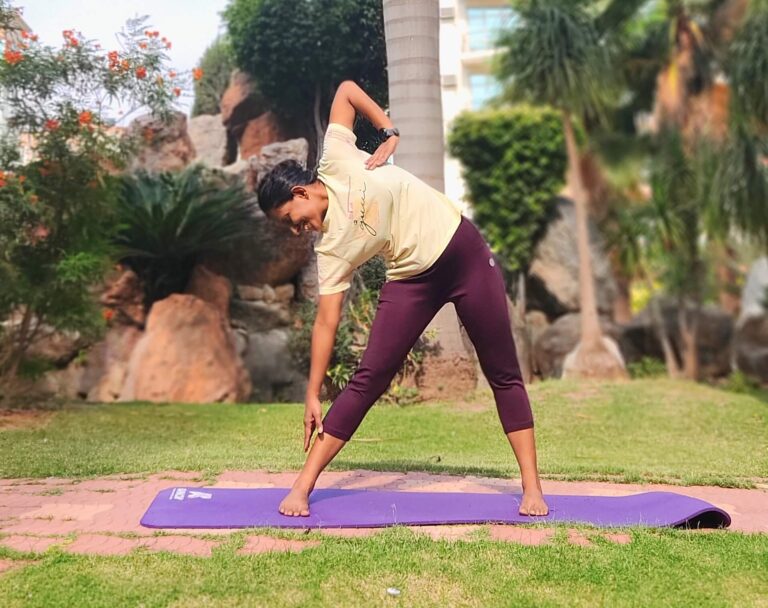
Standing Position – Sideward Bend
Kona is Angle; Konasana meaning Angle Pose.
In this asana, begin with standing 2 feet apart with the feet parallel to each other and both arms by the side.
Raise the right palm to waist with fingers facing forward and thumb behind.
As you inhale in 3 seconds turn the head to gaze over the left shoulder and bend the torso to the left side and raise the right palm to armpit with elbow pointing to the ceiling and slide the left arm down straight as you continue gazing at the left hand.
The thorax, neck and the head is then at a right angle to the base. Ensure the body does not incline forward but sidewards in an aligned vertical plane.
Hold this pose for 6 seconds.
While exhaling smoothly raise the torso back to the starting position and the hands slide back to their respective sides. Repeat the same on the other side. Repeat the same on the left side to complete 1 round. Practise 2 full rounds.
Contraindications:
Spinal injury, Back injury or Shoulder injury, Frozen shoulder and severe Arthritis, Hypertension and serious cardiac complaints. Pregnant women in 2nd & 3rd Trimester must refrain.
Benefits:
Stretches the sides of the body and the spine
Strengthens intercostal muscles and hence breathing capacity
Helps in toning arms, legs, plus abdominal and pelvic organs
Helpful in relieving back pain
Increases the flexibility of the spine
Helps those who are suffering from constipation
Helpful for people suffering from sciatica
Konasana 1 is a preparatory asana for Urdhva Hastasana and Ardha Chakrasana. So practice Konasana well and we will soon learn these advanced asanas.
Trikonasana

Standing Position – Sideward Bend
Trikona meaning Triangle
In this pose, begin with both feet 3 feet apart. Turn the right foot out pointing to the right at a right angle to the left foot.
Inhaling in 3 seconds raise both arms out at shoulder level with palms facing downward.
Exhaling in 3 seconds and gazing at the right palm, extend and lower the right palm to the right foot at the same time raising the left arm straight above .Then turn the gaze to the left thumb of the arm above. The legs and hands are straight. The upper left hand and lower right hand are aligned in one straight line lift the left shoulder up so that the shoulder is also in one line aligned with the arms.
Hold this pose for 6 seconds.
As you exhale in 3 seconds turn your gaze to the lower arm, raise both arms to shoulder level and lower them down by your sides.
Repeat the same on the left side.
This is one round. Practise 3 rounds.
Contraindications:
Spinal injury, Back injury or Shoulder injury, Frozen shoulder, severe Arthritis, Hypertension and serious cardiac complaints.
Benefits:
Stretches, develops and tones the muscles of the sides and the obliques
Strengthens the back and improves posture
A very good compression and twist to the abdomen and the organs therein
Improves digestion
Stimulates the nervous system
Relieves symptoms of menopause
Ekpadasana
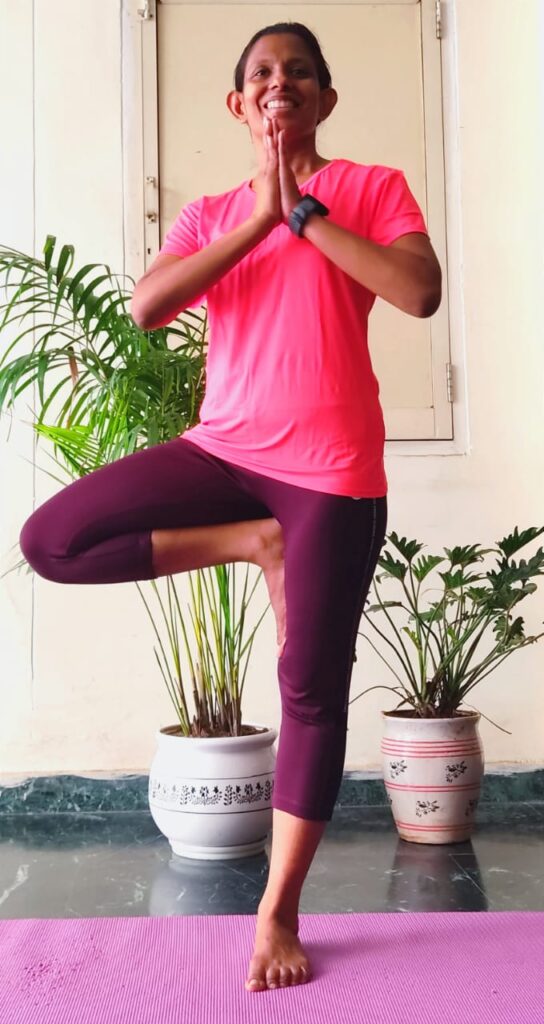
Standing Asana – Balancing Pose
Meaning the One Leg Pose. This asana harmonizes both mind and body.
In this asana, you stand with your feet together and hands by your side.
Raise your right foot and press the sole of your foot against the left thigh as high as you can, close to the groin and toes pointing down. If difficult, avoid placing the foot against the knees but rest the foot, wherever comfortable, against the thigh.
Balance your body weight on the right leg. Once the balance is achieved, join both your palms in a prayer pose. Breathe normally.
Maintain the pose for a few seconds. Try to fix your gaze at one point ahead to maintain balance.
Bring your leg down and hands down by the sides and repeat the same procedure with the opposite leg. You can hold the pose up to a minute.
Contraindications:
Severe arthritis, Lower back pain, Sciatica, Slipped disc, vertigo. Those with weak legs, lack of or very weak neuromuscular coordination.Benefits:
Strengthens the muscles of the legs and spine.
Improves your body balance, endurance, and alertness.
Strengthens the bones.
Stimulates the nervous system.
Improves concentration focus and ability to balance.
Calms the mind.
